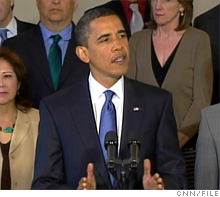Obama to workers: We'll help you save
President announces measures to make it easier to save more. One new idea: Turn tax refunds into savings bonds.
 |
| Obama encourages more savings in retirement plans. |
WASHINGTON (CNNMoney.com) -- President Obama on Saturday announced changes that the IRS plans to make to encourage workers to save more of their paychecks.
"Even before this recession hit, the savings rate was essentially zero, while borrowing had risen and credit card debt had increased," Obama said in his weekly radio and Internet address. "More broadly, tens of millions of families have been, for a variety of reasons, unable to put away enough money for a secure retirement. ... We cannot continue on this course."
Most of the following changes will take effect immediately because of rule changes made by the Treasury Department.
Auto enrollment in retirement plans: To make it easier for smaller and medium-sized employers to automatically enroll workers into retirement plans, the administration will clear up some bureaucratic paper-work hurdles for employers to offer that option. Employees could still choose to opt out of the retirement plans.
Saving tax refunds: To make it easier for those owed tax refunds to save, the IRS will allow tax filers in 2010 to recoup their refund by issuing U.S. savings bonds.
Sick days and vacation time become 401(k) money: To make it easier for workers to rack up savings, the White House will make it easier for employers to convert (or allow workers to convert) unused vacation and sick leave pay into 401(k) contributions.
Americans have not been good savers in recent decades.
Recently, personal savings rates have increased, rising from essentially zero last year to about 4.2% in July, according to government statistics.
But even among those with savings in the bank, the nest egg is relatively lean. Of workers 55 years or older, about half have less than $50,000 in savings, excluding their homes and pensions, according to the Employee Benefit Research Institute.
"Today, the administration announced steps we are taking to make it easier for working families to save, particularly for retirement," said Treasury Secretary Tim Geithner in a prepared statement. "Working Americans should be able to retire with dignity and security, but nearly half of the nation's workforce has little or nothing beyond Social Security benefits to get by on in old age."
However, the impact of many of the administration's changes could be modest, since the changes will be voluntary for employers and employees.
Senior administration officials explained that the moves are meant to complement legislative proposal announced earlier to encourage workers to build retirement savings, which wouldn't go into effect until 2011.
The officials said they're not sure how much the new rules will help boost national savings rates but that they're targeting those who are saving too little.
They acknowledged that a spike in short-term savings could hurt the recovery, but say they believe their changes will have a longer-term impact.
Most of the changes would not impose new mandates on employers.
For example, a company that doesn't compensate employees for unused vacation and sick leave, under "use it or lose it" policies, would not be required to start compensating employees for unused time through 401(k) contributions.
The measures detailed Saturday are in addition to two other Obama proposals to promote retirement savings. Both seem to be in limbo, pushed behind bigger priorities like health care.
Congress has introduced a bill that would force employers that don't currently offer retirement plans to automatically enroll their workers in a direct-deposit IRA. Employees would be allowed to opt out.
The other proposal would expand the saver's credit, a tax credit for middle- or low-income workers who save through 401(k)s or IRAs. The bill would allow more people at higher incomes to qualify for the credit and allow more low-income wage earners who don't pay federal income tax to also benefit.
Together these moves would increase savings participation for this group of workers to 80% from 15%, according to White House estimates. But the plan's cost is $59.6 billion over the next 10 years, which has rankled congressional Republicans worried about growing deficits. ![]()


